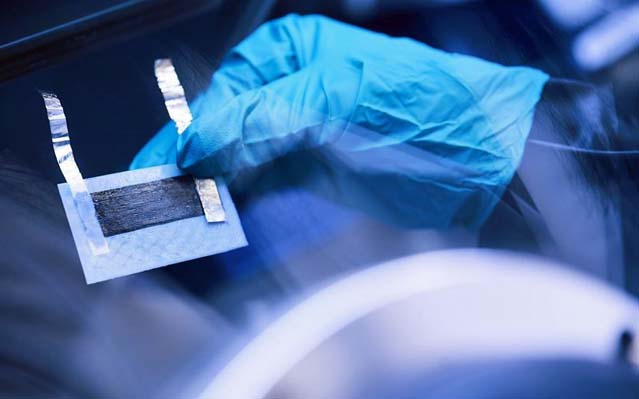A new press release from Chalmers University of Technology In Sweden begins: “When cars, planes, ships or computers are built from a material that functions as both a battery and a load-bearing structure, the weight and energy consumption are radically reduced”.
A Chalmers research group is presenting a significant advance in so-called massless energy storage – a structural battery that could reduce the size and weight of IT devices, or increase the driving range of an electric car by up to 70% on a single charge.
Structural batteries are materials that, in addition to storing energy, can carry loads. In this way, the battery material can become part of the actual construction material of a product, which means that much lower weight can be achieved.
Research on structural batteries has been going on for many years at Chalmers, together with the KTH Royal Institute of Technology in Stockholm. When Prof Leif Asp and colleagues published their first results in 2018 on how stiff, strong carbon fibres could store electrical energy chemically, the advance attracted massive attention.
Since then, the research group has further developed its concept to increase both stiffness and energy density. The previous milestone was reached in 2021 when the battery had an energy density of 24 watt-hours per kilogramme (Wh/kg), which means roughly 20% capacity of a comparable lithium-ion battery. Now it’s up to 30 Wh/kg. While this is still lower than today’s batteries, it is approaching the stage where the battery can become part of the construction and can also be made of a lightweight material, so overall weight is greatly reduced. Then not nearly as much energy is required to drive an electric car, for example.
Although there has been interest from the maritime and aerospace sectors, it is acknowledged that many questions still remain. It seems unlikely that the hull of a large containership, for example, could economically be made from carbon fibre with the required high strength, light weight and battery energy density. And with the life of a large ship in the order of 20-30 years, the structural battery would need to offer an equivalent timescale. But there are possibilities in using significant parts of a vessel to provide electrical storage, and there is distinct promise in applications like the lightweight small electric passenger ferries that are entering the marketplace.
Chalmers researcher Richa Chaudhary said: “We have succeeded in creating a battery made of carbon fibre composite that is as stiff as aluminium and energy-dense enough to be used commercially. Just like a human skeleton, the battery has several functions at the same time.”
Prof Asp added: “Investing in light and energy-efficient vehicles is a matter of course if we are to economise on energy and think about future generations. We have made calculations on electric cars that show that they could drive for up to 70% longer than today if they had competitive structural batteries.”
When it comes to transportation applications, there are high demands on the design to be sufficiently strong to meet safety requirements. The research team’s structural battery cell has significantly increased its stiffness, or more specifically, the elastic modulus, which is measured in gigapascal (GPa), from 25 to 70. This means that the material can carry loads just as well as aluminium, but with a lower weight.
Prof Asp continued: “In terms of multifunctional properties, the new battery is twice as good as its predecessor – and actually the best ever.”
Asp’s research began in 2007, and from the start, the goal was to achieve a performance that makes it possible to commercialise the technology. The link to actual markets has now been strengthened – through the newly started Chalmers Venture company Sinonus, based in Borås, Sweden. However, there is still a long way to go before the battery cells have taken the step from lab manufacturing on a small scale to being produced on a large scale for technology gadgets or vehicles.
Asp said: “One can imagine that credit card-thin mobile phones or laptops that weigh half as much as today, are the closest in time. It could also be that components such as electronics in cars or planes are powered by structural batteries. It will require large investments to meet the transport industry’s challenging energy needs, but this is also where the technology could make the most difference.”
The developed battery concept is based on a composite material and has carbon fibre as both the positive and negative electrodes – where the positive electrode is coated with lithium iron phosphate. When the previous battery concept was presented, the core of the positive electrode was made of an aluminium foil.
The carbon fibre used in the electrode material is multifunctional. In the anode it acts as a reinforcement, as well as an electrical collector and active material. In the cathode it acts as a reinforcement, current collector, and as a scaffolding for the lithium to build on. Since the carbon fibre conducts the electron current, the need for current collectors made of copper or aluminium (for example), is reduced, which reduces the overall weight even further. Nor are any so-called conflict metals such as cobalt or manganese required in the chosen electrode design.
In the battery, the lithium ions are transported between the battery terminals through a semi-solid electrolyte, instead of a liquid, which is challenging when it comes to higher power and for this more research is needed. At the same time, the design contributes to increased safety in the battery cell, through reduced risk of fire.
The research has been funded by the Wallenberg Initiative Materials Science for Sustainability (WISE) programme.
Image: Research continues into structural batteries – i.e. using the structure of an item to store the energy needed to power it (credit: Chalmers University of Technology)



